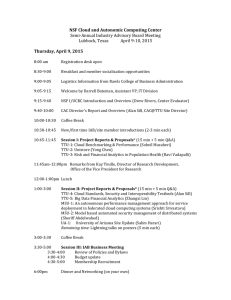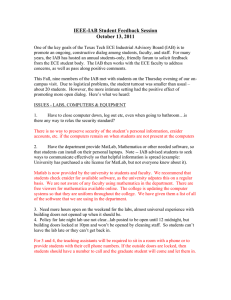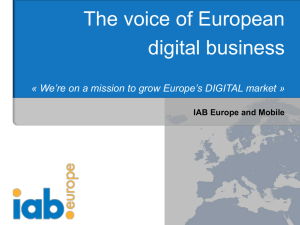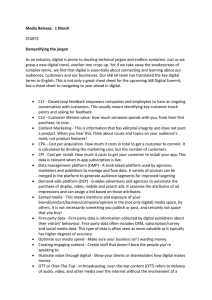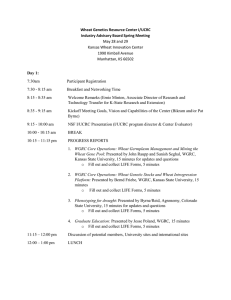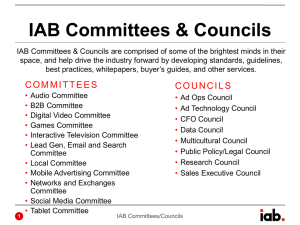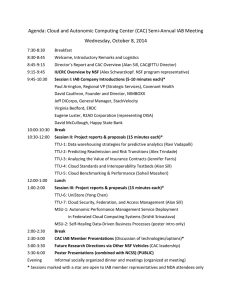The European Commission Impact Assessment System
advertisement
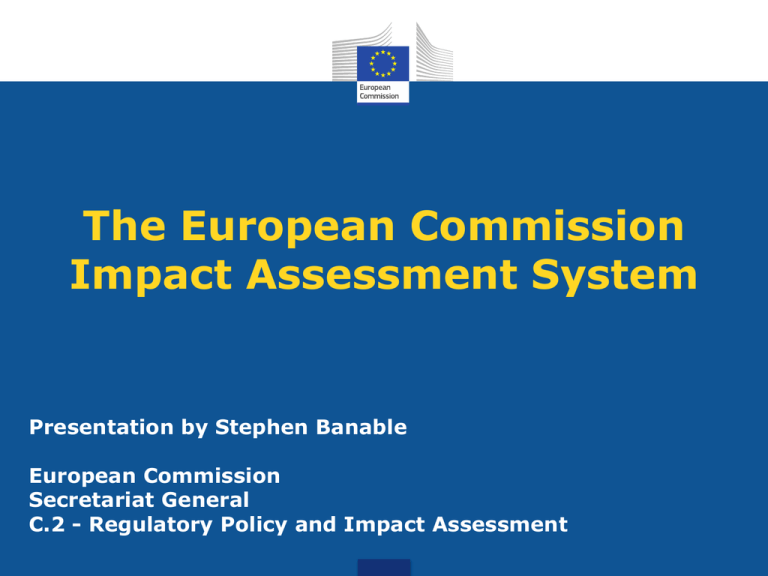
The European Commission Impact Assessment System Presentation by Stephen Banable European Commission Secretariat General C.2 - Regulatory Policy and Impact Assessment Context: Smart Regulation SMART Achieves goals No unnecessary cost Subsidiarity and proportionality Evidence-based policy-making Political decision Proportionality Impacts Options Objectives Subsidiarity Problem Why? How? Evidence Base Consultations Evaluations Implementation The Policy Cycle An IA supports the Commission decision-making 1. Identify the problem 2. Assess need for EU-level intervention 3. Define the objectives 4. Develop policy options 5. Analyze the impacts of the options 6. Compare the options 7. Outline policy monitoring and evaluation Characteristics of Commission IA system Integrated approach • All benefits and costs. Economic, social and environmental impacts. Wide scope • All initiatives with significant impacts, from policy defining proposals to implementing measures Transparency • Publication of Roadmaps, IAs and IAB opinions • Comprehensive stakeholder consultation Independent quality control – Impact Assessment Board Initiate stage: the process inside the Commission The IA process: sequence Idea Screening: proceed? is IA needed? IA process: consult, get data, analyse, draft report Impact Assessment Board Revise IA and proposal Internal interservice consultation Legislate stage College (political approval) Publish Proposal development Roadmap Consultation request Consultation: report on findings Initiate stage: outputs seen by outside stakeholders Proposal, Impact Assessment reports, Board Opinion Outputs • The IA report: • Summarizes the results of the process • Simple, easy to read and non-technical • Short: around 30 pages • The executive summary of the IA report: • < 10 pages, following IA report structure • Translated to all languages • Aims to give a fair and complete overview of the analysis • The two-page summary sheet IA guidelines set the reference framework I. Procedural Standards • When to do an IA • IA Planning • IA Steering Groups • IA Report requirements • IAB procedure • ISC / Adoption • IA use in Council / EP • Consultation / Expertise II. Analytical Standards • Problem Definition / Subsidiarity • Policy Objectives • Policy Options • Analysis of Impacts • Comparison of Options • Monitoring & Evaluation III. Annexes (f.ex. Specific guidance on quantitative models, risk analysis, applicaton of the standard cost model etc) Complementary operational guidance (f.ex. on social impacts, fundamental rights, competitiveness, SME‘s…) How to ensure quality • Comprehensiveness. All relevant services involved + extensive stakeholder consultations. • Accountability and transparency. All IAs and IAB opinions are published once COM has adopted the relevant proposal. Roadmap are published as early as possible. • Methodological support Extensive training and guidance (including on specific impacts) Strong central quality control The Impact Assessment Board • Established at end-2007, the IAB: Examines all the Commission's IA. Issues opinions asking for improvements or resubmission In principle a positive opinion is required for a proposal to be tabled to the Commission The Impact Assessment Board • The IAB is independent of policy-making departments: Members are high-level officials appointed in a personal capacity On the basis of their expert knowledge in the three pillars of the integrated approach (economic, social and environmental impacts). Chair: Deputy Secretary General for Smart Regulation. Nine members share the work on a rotating basis to ensure a sustainable work burden and avoid conflict of interests while preserving the required expertise in all three areas. The author DG sends draft IA report to the IAB (8 weeks before launch inter-service consultation) DG answers to the comments either in writing or orally during an IAB meeting The proposal is tabled for interservice consultation and then Commission approval together with the revised IA report and the Board opinion How does IAB scrutiny work? The IAB sends detailed comments to the DG (Impact Assessment Quality Checklist) •The IAB issues the opinion •Critical opinion may lead to resubmission Opinion (and final IA) is published externally (on Europa website) once the policy initiative is adopted by the Commission Board quality control activities 2007 2008 2009 2010 2011 2011 - MFF 2012 IAs 102 135 79 66 104 43 97 Opinions 112 182 106 83 138 37 144 Resubm. rate 9% 33 % 37 % 42 % 36 % n/a 47% Trends in Board recommendations (1) Trends in Board recommendations (2) Drivers behind the culture change Strong political commitment Transparency Direct responsibility of the President Roadmaps Part of Commissioner mission letter Consultation Positive IAB opinion needed to table proposal Publication of IA reports / IAB opinons Operational ownership Central support IA integral part of policy process Guidance Engagement in IA Steering Groups IAB DG „signs off“ IA reports for IAB submission IA working group IA support functions/ help desks Training Results so far … • More than 600 IAs, over 500 IAB opinions since 2007 • 2010 ECA audit found that: • Commission IA system is effective in supporting EU decision making • No other system has a similar comprehensive approach • Consultations with stakeholders are widely used • IAB is contributing to quality of proposals • IA reports comply with the IA guidelines • Findings confirmed by more recent studies (EP „Matrix“ study, CEPS study, OECD) • Only little IA work during the legislative phase despite commitment to have IA for "substantial amendments" • But EP has setup an IA unit Information sources • Communication on EU Regulatory Fitness http://ec.europa.eu/governance/better_regulation/documents/1_EN_ACT_part 1_v8.pdf • Court of Auditors report http://eca.europa.eu/portal/pls/portal/docs/1/5372733.PDF • Detailed information about forthcoming initiatives - roadmaps http://ec.europa.eu/governance/impact/planned_ia/planned_ia_en.htm • IA reports and IAB opinions http://ec.europa.eu/governance/impact/practice_en.htm • Impact Assessment guidelines http://ec.europa.eu/governance/impact/docs_en.htm • EC Better Regulation website http://ec.europa.eu/governance/better_regulation/index_en.htm Thank you
